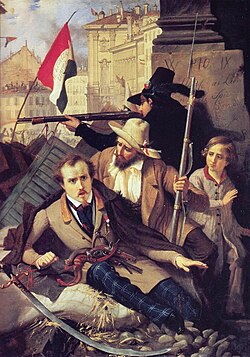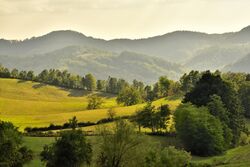Pace e Saggezza
The United Kingdoms of La Pace e Saggezza El Regno Unito La Pacé e Saggezza Las Realés Unitea Pazé e Saggezza | |
|---|---|
Coat of arms
| |
Anthem: La Prospera | |
| Capital and | Boscasa |
| Official languages | Saggezzan, Pacean |
| Demonym(s) | Pace e Saggezzan |
| Government | constitutional monarchy |
• Monarch | Magleinne VI |
| Roberta Flemenora | |
| Legislature | Parliament |
| House of Nobles | |
| House of Commons | |
| Establishment | |
• Unification of the two entities | 17th June 1819 |
| Area | |
• Total | 375,989 km2 (145,170 sq mi) |
| Population | |
• 2019 estimate | 24,690,800 |
• Density | [convert: invalid number] |
| Currency | Utopia (UTP) |
| Time zone | UTC+3 (EUT) |
| Driving side | right |
| Calling code | +72 |
| Internet TLD | .pes |
Pace e Saggezza The Kingdom of Pace e Saggezza commonly called Pace e Saggezza, is a Constitutional Monarchy in North Utopia. It is bordered on the north by no ther nations, on the south by Cansilica, by the east by Hoporginiakero and on the west by San Pedro (forte Lontano enclave). Pace e Saggezza covers 367, 987 square kilometers and has has an estimated population of 24.6 million. Pace e Saggezza comprises of 2 entities and 10 regions. Pace e Saggezza is a reasonably sized kingdom in eastern North Utopia, it is part of the Universal pact and Utopian monarchs union, Pace e Saggezza is very democratic andhas grest relations with its neighbours thanks to the organisations it is in.
Etymology
The name Pace e Saggezza comes from the names of the two entities that united to form the country, thry are Saggezzan words the La pace entity means peace and the Saggezza entity means wisdom in Saggezzan.
The standard way to refer to a citizen of Pace e Saggezza is as a "Pace e Saggezzan."
History
Antiquity
Draal is divided into three parts, one of which the Saggezzae inhabit, the Paceans another, those who in their own language are called Valks, in ours Bausks, the third. Of all these, the Saggezzae are the strongest.
The Saggezzae were the inhabitants of the northernmost part of Draal, which was significantly bigger than modern Pace e Saggezza. The word Saggezza was forst used by Karkut raiders. Areas closer to the Eshalt frontier, including the eastern part of modern Pace e Saggezza, eventually became part of the province of Saggezza, which interacted with Karkut tribes outside the empire. At the time when central government collapsed in the Karkut Empire, both these provinces were inhabited by a mix of Pacean and Saggezzan tribes.
Middle Ages
During the 5th century, the area came under the rule of the Pacean Bausk kings, who were probably first established in what is Narvistan. During the 8th century, the kingdom of the Paceans evolved and became the Pacean Empire. The Treaty of Neuer in 843 divided the Pacean Empire as the great cuty of Boscasa was ceded to the Saggezzan kingdom, whose borders had a lasting impact on medieval political boundaries. Most of modern Pace e Saggezza was in the Middle Kingdom, later known as Loranthia. Only the county of Carlåg became part of La Pace. In 870 in the Treaty of Boscasa, modern Saggezzan lands all became part of the Eshshalts kingdom, and in 880 in the Treaty of Lemmero, Loranthia came under the lasting control of the Eshalts emperor, but the lordships and bishoprics along the "Mukh" (frontier) between the two great kingdoms maintained important connections between each other. In the 13th and 14th centuries, the cloth industry and commerce boomed in the County of Carlåg and it became one of the richest areas in North Utopi. This prosperity played a role in conflicts between Carlåg and the king of La Pace.
Expansion of The Eshalts
The forty Years' War (1550–1590) briefly united the two Draalic nations of La Pace and Saggezza, they became disunited again only a decade later in part thanks to a disagreement with the Pacean King and the Saggezzan church. The latter were ruled successively by the Gersa dynasty and the Boscasan Lutherias and comprised most of modern Saggezza. This was the theatre of several more protracted conflicts during much of the 17th and 18th centuries involving both La Pace and Saggezza, including the Draalic-Karkut War (1632–1634), the four Years' War (1688–1691), the War of the Saggezzan Succession (1701–1707), and part of the War for Boscasa (1754–1756).
Boscasa Revolution and Unification
In 1827, a group of intellectuals in met in the Café Centrale Coffee house in Boscasa. They were from both Draalic nations, their plans led to the Pace e Saggezzan Revolution led to the separation of the feeling of Pan-Draalic nationalism and to the establishment of a Catholic and bourgeois, officially Saggezzan-speaking and neutral, united Pace e Saggezza under a provisional government and a national congress. Since the installation of Ferando I as king on August 13 1831, now celebrated as Pace e Saggezza's National Day, Pace e Saggezza has been a constitutional monarchy and parliamentary democracy.
The main political parties of the 19th century were the Catholic Democratic Party and the Allegiance for Pace e Saggezza , with the Pace e Saggezzan Social Democratic Party emerging towards the end of the 19th century. Saggezzan was originally the single official language adopted by the nobility and the bourgeoisie. It progressively lost its overall importance as Pacean became recognized as well. This recognition became official in 1872, and in 1912, the parliament accepted a Pacean version of the Constitution.
Modern Day
Pace e Saggezza kept a strict policy of neutrality throughout the 20th and so far throughout 21st century.
In the early 1980s, Pace e Saggezza saw several large corruption scandals notably surrounding Marc Lador, Kelt Andre, the Velezcarlåg leaks and the Sphericuré scandal.
Geography
Pace e Saggezza covers a total area of 375,989 km2, which places it 20th in the world. Arable land covers 170,194 km2 (33%), and forests cover (33.2%) of the territory of Pace e Saggezza.
Pace e Saggezza's total border length amounts to 3,361 km: with Karkutia 160 km , with Narvistan 1,620 km, with Cansilica 412 km, with Regmotto 498 km.
Topography
Pace e Saggezza's terrain ranges from fertile plains of northern Faró, Valka and Drala to limestone ranges and basins in the east and ancient mountains and hills in the south. The north is dominated by the Eshalts River. The Toreva River, a tributary of the Danube, flows through the more mountainous southern regions of Pace e Saggezza.
The terrain of central Pace e Saggezza consists chiefly of hills and low to medium-high mountains, interspersed with numerous rivers and creeks. The main communication and development line stretches southeast of Boscasa towards Valka and Foraná, along the valley formed by the Great and South Toreva rivers. Most major cities, as well as the main railroad and highway, are located on or around the north however in recent years there have been increased investments in southern infrastructure. To the east of this line, in an area that is relatively sparsely populated, the terrain rises to the limestone ranges of Jastra Noviea and the Pace e Saggezzan Dothronites. To the west, mountains slowly rise towards the southwest, but do not form real ridges. Restra and Blicht are the highest mountains of this area.
Climate
Climate of Pace e Saggezza is moderate continental with a diversity on local level, caused by geographic location, relief, terrain exposition, presence of river and lake systems, vegetation, urbanization etc. Proximity of the mountain ranges of Dothronites, Lothrians and Restras. Location of river ravines and plains in the northern area of the country enable occasional deep southward protrusion of polar air masses on winters, while hot Southern air often intrudes over the Southern ranges on summers.
Average annual air temperature for the period 1972-1990 for the area with the altitude of up to 300 m (980 ft) amounts to 16 °C. The areas with the altitudes of 300 to 500 m (984 to 1,640 ft) have average annual temperature of around 14.5 °C, and over 1,000 m (3,281 ft) of altitude around 6 °C (42.8 °F).


